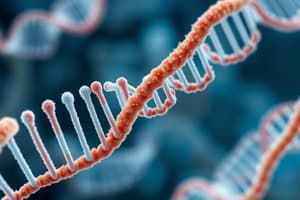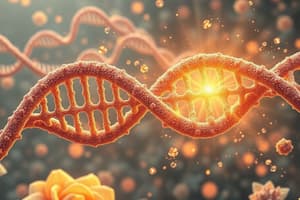Podcast
Questions and Answers
What is translation and where does it occur?
What is translation and where does it occur?
Translation is the process by which an mRNA is translated into protein. This process occurs in the cytoplasm.
What are the stop codons?
What are the stop codons?
UAA, UAG, UGA
How many codons can encode an amino acid?
How many codons can encode an amino acid?
An amino acid may be encoded by multiple codons.
Compare the nuclear and mitochondrial genetic codes.
Compare the nuclear and mitochondrial genetic codes.
What are tRNAs?
What are tRNAs?
What adds the sequence CCA to the 3' end of all tRNAs?
What adds the sequence CCA to the 3' end of all tRNAs?
What do tRNAs contain?
What do tRNAs contain?
How many codons do tRNAs recognize and what is wobble base pairing?
How many codons do tRNAs recognize and what is wobble base pairing?
What is the function of ribosomes in translation?
What is the function of ribosomes in translation?
Describe the structure of a ribosome.
Describe the structure of a ribosome.
What do ribosomes act as?
What do ribosomes act as?
Describe the steps of protein synthesis: attachment of amino acids to tRNAs.
Describe the steps of protein synthesis: attachment of amino acids to tRNAs.
Describe the two adaptors that act one after another to translate the genetic code.
Describe the two adaptors that act one after another to translate the genetic code.
What complex is involved for the initiation of protein synthesis, and what does this complex do?
What complex is involved for the initiation of protein synthesis, and what does this complex do?
What is the result of the complex finding the AUG codon?
What is the result of the complex finding the AUG codon?
Describe the initiation and elongation of protein synthesis.
Describe the initiation and elongation of protein synthesis.
Describe the termination of protein synthesis.
Describe the termination of protein synthesis.
Flashcards are hidden until you start studying
Study Notes
Translation Process
- Translation converts mRNA into protein in the cytoplasm.
- Ribosomes are the site of protein synthesis.
Codons and tRNAs
- Stop codons: UAA, UAG, UGA signify the end of translation.
- Each amino acid can be encoded by multiple codons; however, a specific codon uniquely encodes a single amino acid.
- tRNAs act as adapters between mRNA codons and amino acids, containing anticodons complementary to mRNA.
Genetic Code
- Nuclear and mitochondrial genetic codes share similarities but differ in specifics.
- Wobble base pairing allows a tRNA to recognize multiple codons due to fewer tRNAs (about 50 in humans) than codons.
tRNA Structure
- tRNAs possess conserved secondary/tertiary structures and modified nucleotides.
- Anticodons of tRNAs are anti-parallel and complementary to the mRNA codons (e.g., for 5'−AUG−3', the tRNA anticodon is 3'−UAC−5').
Ribosome Structure
- Ribosomes are large complexes of rRNAs and proteins, with eukaryotic ribosomes being 80S (60S large subunit and 40S small subunit).
- The 60S subunit includes about 50 proteins and several rRNAs (28S, 5.8S, 5S), while the 40S contains around 30 proteins and 18S rRNA.
- Ribosomes function as ribozymes, with RNA catalyzing the peptidyl transferase reaction.
Protein Synthesis
- Amino acids are attached to tRNAs at the CCA sequence via aminoacyl-tRNA synthetases, requiring ATP.
- Two adaptors operate sequentially: aminoacyl-tRNA synthetase (charging the tRNA) and the tRNA itself (pairing with mRNA codons).
Initiation of Protein Synthesis
- Initiation complex includes Met-tRNA, several initiation factors, GTP, and the 40S ribosome, scanning for the first AUG codon.
- Finding the AUG codon triggers the association of the 60S subunit to form the 80S initiation complex, starting protein synthesis.
Elongation Phase
- A second charged tRNA binds to the next mRNA codon, involving elongation factors and GTP.
- The ribozyme catalyzes peptide bond formation between amino acids.
- Ribosome translocates to the next codon, requiring GTP hydrolysis and the translocase enzyme (EF2), continuing until a termination codon is reached.
Termination of Protein Synthesis
- Protein synthesis concludes upon encountering a termination codon, completing the translation process.
Studying That Suits You
Use AI to generate personalized quizzes and flashcards to suit your learning preferences.




